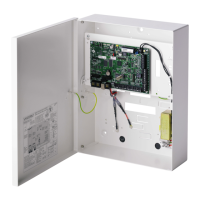Engineer programming via the keypad
Installation & Configuration Manual
DPS End Of Line (keypads)
Door Position EOL (SPC Pro)
the used resistor value / combination.
Select if the door release switch is to be a normally open
or normally closed input.
DRS END OF LINE (Keypads)
Door Position EOL (SPC Pro)
The resistor used with the door release switch. Choose
the used resistor value / combination.
Select if the door release switch is a normally open input
or not.
No DRS
(Web and SPC Pro only)
If a DC2 is used on the door, this option MUST be
selected. If not selected, the door will open.
Reader Location (Entry/Exit)
Select the location of the entry and exit readers.
Displays format of last card used with each configured
reader. (not available in SPC Pro)
Each free zone number can be assigned to the zones but the assignment is not
fixed. If the number ‘9’ is assigned to a zone, the zone and an input expander with
the address ‘1’ is connected to the X-Bus (which is using the zone numbers 9-16).
The assigned zone from the two door controller will be moved to the next free
zone number. Configuration will be adapted accordingly.
Door Groups
The different doors can be assigned to door groups. This is needed if one of the
following functionalities is activated:
Custodian
Soft Passback
Prevent Passback
Interlock
Door attributes
If no attribute is activated, a valid card can be used.
The card is temporarily blocked.
Used when multiple doors are assigned to the same
area and/or anti passback, custodian, or interlock
functionality is required.
Card and PIN are required to gain entry.
PIN is required. No card will be accepted.
PIN or card are required to gain entry
PIN is required on exit reader. Door with entry and
exit reader is required.
